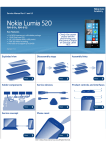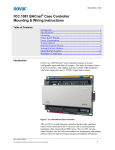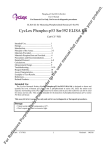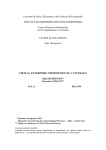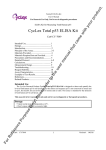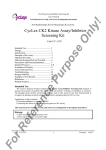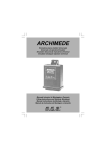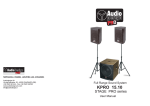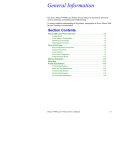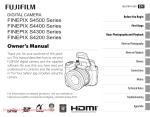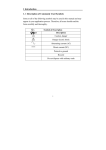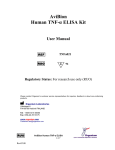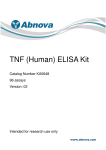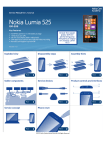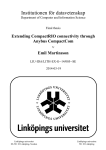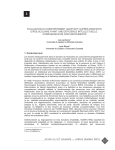Download CY-1181
Transcript
Non-Radioisotopic Kit for Measuring DYRK2 activity On ly! DYRK2 Kinase Assay/Inhibitor Screening Kit User’s Manual For Research Use Only, Not for use in diagnostic procedures CycLex DYRK2 Kinase Assay/Inhibitor Screening Kit Pu rp Intended Use................................................ 1 Storage......................................................... 1 Introduction.................................................. 2 Principle of the Assay.................................. 3 Materials Provided....................................... 4 Materials Required but not Provided........... 4 Precautions and Recommendations............. 5 Detailed Protocol......................................... 6-9 Evaluation of Results................................... 10 Assay Characteristics................................... 10 Troubleshooting........................................... 10 Reagent Stability.......................................... 10 Example of Test Results............................... 11-12 References.................................................... 13 Related Products........................................... 14 os e Cat# CY-1181 ce Intended Use en The CycLex Research Products CycLex DYRK2 Kinase Assay/Inhibitor Screening Kit designed to measure the activities of purified DYRK2 for the rapid and sensitive evaluation of inhibitors or activators. The phospho-serine specific monoclonal antibody used in this assay kit has been demonstrated to recognize the phospho-serine 46 residue in p53, which is phosphorylated by DYRK2 in vitro. er Applications of this kit include: 1) Screening inhibitors or activators of DYRK2. 2) Detecting the effects of pharmacological agents on DYRK2 activity. This assay kit is for research use only and not for use in diagnostic or therapeutic procedures. Storage rR ef • Upon receipt store all components at 4°C. • Don’t expose reagents to excessive light. Fo Cat#: CY-1181 1 Version#: 140318 On ly! DYRK2 Kinase Assay/Inhibitor Screening Kit User’s Manual For Research Use Only, Not for use in diagnostic procedures Introduction Measurement of DYRK2 activity Pu rp os e DYRKs (dual specificity tyrosine phosphorylation-regulated kinases) constitute an evolutionarily conserved family of proline or arginine-directed protein kinases belonging to the CMGC family of cyclin-dependent kinases (CDKs), mitogen-activated protein kinases (MAPKs), GSK and CDK-like kinases (CLKs) (1, 2). DYRKs autophosphorylate a critical tyrosine residue in the kinase domain activation loop, but phosphorylate exogenous substrates exclusively on serine and threonine residues (3). DYRK family members consist of a conserved central kinase domain and adjacent N-terminal DH-box (DYRK homology box), but differ in their N- and C-terminal extensions (2, 4). DYRK family members are involved in regulating key developmental and cellular processes such as neurogenesis, cell proliferation, cytokinesis, and cellular differentiation. Recent findings have shown that DYRK1A and DYRK2 phosphorylate NFATc, which regulates calcium signaling, to lead NFATc inactivation by its cytoplasmic sequestration (5, 6) It was reported that DYRK2 was overexpressed in both lung and esophageal adenocarcinomas showing gene amplification at 12q14 (7). Recently Taira et al. reported that in response to genotoxic stress, DYRK2 translocated into the nucleus and phosphorylated p53 on ser46, inducing P53AIP1 expression and apoptosis in a ser46 phosphorylation-dependent manner. These results suggest that DYRK2 regulates p53 to induce apoptosis in response to DNA damage (8). rR ef er en ce The protocol generally regarded as most sensitive for the quantitative measurement of DYRK2 activity involves incubation of the DYRK2 sample with substrate, either a natural or synthetic polypeptide (such as DYRK2 substrate peptide; KKISGRLSPIMTEQ: Woodtide), in the presence of Mg2+ and 32P-labeled ATP. The reaction is terminated by "spotting" a sample onto a phosphocellulose P81 filter paper disc, followed by washing extensively to remove unincorporated radiolabel and the incorporated radioactivity on P81 filter is counted. While sensitive, this method is labor-intensive, generates hazardous radioactive waste, and depends on a radioisotope of short half-life. It is particularly unsuitable when kinase assays are only performed on an infrequent basis. The CycLex Research Product CycLex DYRK2 Kinase Assay/Inhibitor Screening Kit uses a peroxidase coupled anti-phospho-p53 serine46 monoclonal antibody as a reporter molecule in a 96-well ELISA format. This assay provides a non-isotopic, sensitive and specific method to detect DYRK2 activity. Fo Cat#: CY-1181 2 Version#: 140318 On ly! DYRK2 Kinase Assay/Inhibitor Screening Kit User’s Manual For Research Use Only, Not for use in diagnostic procedures Principle of the Assay Pu rp os e The CycLex Research Product CycLex DYRK2 Kinase Assay/Inhibitor Screening Kit is a single-site, semi-quantitative immunoassay for DYRK2 activity. Plates are pre-coated with a substrate corresponding to recombinant p53, which contains a serine residue that are phosphorylated by DYRK2 (Dual specificity tyrosine phosphorylation-regulated kinases 2). The detector antibody specifically detects only the phosphorylated form of serine46 on p53. The CycLex Research Product CycLex DYRK2 Kinase Assay/Inhibitor Screening Kit can be used to study the kinetics of a purified or partially purified DYRK2 as well as to screening these kinases inhibitor. To perform the test, the sample is diluted in Kinase Buffer, pipetted into the wells and allowed to phosphorylate the bound substrate in the presence of Mg2+ and ATP. The amount of phosphorylated substrate is measured by binding it with a horseradish peroxidase conjugate of TK-4D4, an anti-phospho-p53 serine46 specific antibody, which then catalyzes the conversion of the chromogenic substrate tetra-methylbenzidine (TMB) from a colorless solution to a blue solution (or yellow after the addition of stopping reagent). The color is quantified by spectrophotometry and reflects the relative amount of DYRK2 activity in the sample. For kinetic analysis, the sample containing DYRK2 is added to the wells in a similar fashion and at varying times the reaction is stopped by the addition of a chelator, sodium ethylenediaminetetraacetate (EDTA) and the amount of phosphorylated substrate determined as before. The CycLex Research Product CycLex DYRK2 Kinase Assay/Inhibitor Screening Kit is designed to accurately determine the presence and relative amount of DYRK2 kinase activity in purification column fractions, and to determine non-isotopic kinetic analysis of DYRK2 activity. Careful attention to methods of chromatography and the assay protocol will provide the investigator with a reliable tool for the evaluation of DYRK2 activity. Summary of Procedure Add 100 µL of reaction mix to the wells ce Incubate for 30 min at 30°C Wash the wells en Add 100 µL of HRP conjugated anti-phosphorylated form specific antibody Incubate for 30 min at room temp. Wash the wells er Add 100 µL of Substrate Reagent ef Add 100 µL of Stop Solution rR Measure absorbance at 450 nm Fo Cat#: CY-1181 3 Version#: 140318 On ly! DYRK2 Kinase Assay/Inhibitor Screening Kit User’s Manual For Research Use Only, Not for use in diagnostic procedures Materials Provided All samples and standards should be assayed in duplicate. The following components are supplied and are sufficient for the one 96-well microtiter plate kit. Microplate: One microplate supplied ready to use, with 96 wells (12 strips of 8-wells) in a foil, zip-lock bag with a desiccant pack. Wells are coated with recombinant p53 N-terminus (1-99 a.a.) as a substrate of DYRK2. os e 10X Wash Buffer: One bottle containing 100 mL of 10X buffer containing 2 %Tween®-20 Kinase Buffer: One bottle containing 20 mL of 1X buffer; used for Kinase Reaction Buffer and sample dilution. 20X ATP: One vial of lyophilized ATP Na2 salt. Pu rp HRP conjugated Detection Antibody: One vial containing 12 mL of HRP (horseradish peroxidase) conjugated anti-phospho-p53 S46 monoclonal antibody (TK-4D4). Ready to use. Substrate Reagent: One bottle containing 20 mL of the chromogenic substrate, tetra-methylbenzidine (TMB). Ready to use. Stop Solution: One bottle containing 20 mL of 1 N H2SO4. Ready to use. Materials Required but not Provided rR ef er en ce • DYRK2 Positive Control: Available from CycLex (Cat # CY-E1181), One vial contains 4 units/100 µL DYRK2 enzyme. Positive control should be added to the first well at 20 m units/well. For instance, diluted positive control 1:20, use 10 µL for 1 assay. (Unused DYRK2 enzyme should be stored in aliquots at -70°C.) • 10X Staurosporine (100 µM): Staurosporine is available from Sigma, Cat#. S4400. 1 mM stock solution (DMSO) diluted 1:10 in Kinase Buffer. • Orbital microplate shaker • Pipettors: 2-20 µL, 20-200 µL and 200-1000 µL precision pipettors with disposable tips. • Precision repeating pipettor • Wash bottle or multichannel dispenser for plate washing. • Microcentrifuge and tubes for sample preparation. • Vortex mixer • Plate reader capable of measuring absorbance in 96-well plates at dual wavelengths of 450 nm/540 nm. Dual wavelengths of 450/550 or 450/595 nm can also be used. The plate can also be read at a single wavelength of 450 nm, which will give a somewhat higher reading. • 500 or 1000 mL graduated cylinder • Reagent reservoirs • Deionized water of the highest quality • Disposable paper towels Fo Cat#: CY-1181 4 Version#: 140318 Precautions and Recommendations On ly! DYRK2 Kinase Assay/Inhibitor Screening Kit User’s Manual For Research Use Only, Not for use in diagnostic procedures • Store the ATP at -20°C in aliquots. Store all other components at 4°C. Do not expose reagents to excessive light. Avoid freeze/thaw cycles. • Allow all the components to come to room temperature before use. • All microplate strips that are not immediately required should be returned to the zip-lock pouch, which must be carefully resealed to avoid moisture absorption. • Use only the microtiter wells provided with the kit. • Rinse all detergent residue from glassware. • Do not mix reagents from different kits. Pu rp • Use deionized water of the highest quality. os e • Do not use kit components beyond the indicated kit expiration date. • The buffers and reagents in this kit may contain preservatives or other chemicals. Care should be taken to avoid direct contact with these reagents. • Do not mouth pipet or ingest any of the reagents. • Do not smoke, eat, or drink when performing the assay or in areas where samples or reagents are handled. ce • Dispose of tetra-methylbenzidine (TMB) containing solutions in compliance with local regulations. • Avoid contact with Substrate Solution which contains hydrogen peroxide. • Avoid contact with Stop Solution which contains Sulfuric Acid. en • In case of contact with the Stop Solution and the Substrate Solution, wash skin thoroughly with water and seek medical attention, when necessary. • Biological samples may be contaminated with infectious agents. Do not ingest, expose to open wounds or breathe aerosols. Wear protective gloves and dispose of biological samples properly. rR ef er • CAUTION: Sulfuric Acid is a strong acid. Wear disposable gloves and eye protection when handling Stop Solution. Fo Cat#: CY-1181 5 Version#: 140318 On ly! DYRK2 Kinase Assay/Inhibitor Screening Kit User’s Manual For Research Use Only, Not for use in diagnostic procedures Detailed Protocol The CycLex Research Product CycLex DYRK2 Kinase Assay/Inhibitor Screening Kit is provided with removable strips of wells so the assay can be carried out on separate occasions using only the number of strips required for the particular determination. Since experimental conditions may vary, an aliquot of the DYRK2 (Cat # CY-E1181), available separately from CycLex, should be included in each assay as a positive control. Disposable pipette tips and reagent troughs should be used for all liquid transfers to avoid cross-contamination of reagents or samples. os e Preparation of Working Solution 1. Prepare a working solution of Wash Buffer by adding 100 mL of the 10X Wash Buffer (provided) to 900 mL of ddH2O. Mix well. Store at 4°C for two weeks or -20°C for long-term storage. 2. Prepare 20X ATP Solution by adding 0.8 mL of ddH2O to the vial of 20X ATP (provided, lyophilized). Mix gently until dissolved. The final concentration of the 20X ATP Solution should be 2.5 mM. Store the solution in small aliquots (e.g. 100 µL) at -20°C. Kinase Buffer (provided) 20X ATP Solution Total Pu rp 3. Prepare Kinase Reaction Buffer by mixing following reagents. 96 assays 10 assays 1 assay 9.5 mL 0.5 mL 950 µL 50 µL 95 µL 5 µL 10 mL 1000 µL 100 µL ce You will need 80-90 µL of Kinase Reaction Buffer per assay well. Mix well. Discard any unused Kinase Reaction Buffer after use. Standard Assay en 1. Remove the appropriate number of microtiter wells from the foil pouch and place them into the well holder. Return any unused wells to the foil pouch, refold, seal with tape and store at 4°C. 2. Prepare all samples (diluted with Kinase Buffer as needed). All samples should be assayed in duplicate. er 3. To assay partially purified recombinant DYRK2, add 10 µL of each fraction to the wells of the assay plate on ice. Duplicate wells containing 20 m units/10 µL DYRK2 (Cat # CY-E1181) should be included in each assay as a positive control for phosphorylation. ef 4. Begin the kinase reaction by addition of 90 µL Kinase Reaction buffer per well, cover with plate sealer, and incubate at 30°C for 30 minutes. rR 5. Wash wells five times with Wash Buffer making sure each well is filled completely. Remove residual Wash Buffer by gentle tapping or aspiration. 6. Pipette 100 µL of HRP conjugated Detection Antibody into each well, cover with a plate sealer and incubate at room temperature (ca.25°C) for 30 minutes. Discard any unused conjugate. Fo Cat#: CY-1181 6 Version#: 140318 On ly! DYRK2 Kinase Assay/Inhibitor Screening Kit User’s Manual For Research Use Only, Not for use in diagnostic procedures 7. Wash wells five times as same as in step 5. 8. Add 100 µL of Substrate Reagent to each well and incubate at room temperature (ca.25°C) for 5–15 minutes. 9. Add 100 µL of Stop Solution to each well in the same order as the previously added Substrate Reagent. os e 10. Measure absorbance in each well using a spectrophotometric plate reader at dual wavelengths of 450/540 nm. Dual wavelengths of 450/550 or 450/595 nm can also be used. Read the plate at 450 nm if only a single wavelength can be used. Wells must be read within 30 minutes of adding the Stop Solution. Note-1: Complete removal of liquid at each step is essential to good performance. After the last wash, remove any remaining Wash Buffer by aspirating or decanting. Invert the plate and blot it against clean paper towels. Pu rp Note-2: Reliable signals are obtained when either O.D. values do not exceed 0.25 units for the blank (no enzyme control), or 2.5 units for the DYRK2 positive control. Note-3: If the microplate reader is not capable of reading absorbance greater than the absorbance of the DYRK2 positive control, perform a second reading at 405 nm. A new O.D. values, measured at 405 nm, is used to determine DYRK2 activity of off-scale samples. The readings at 405 nm should not replace the on-scale readings at 450 nm. Kinetic Assay ce 1. Remove the appropriate number of microtiter wells from the foil pouch and place them into the well holder. Return any unused wells to the foil pouch, refold, seal with tape and store at 4°C. 2. Prepare all samples (diluted with Kinase Buffer as needed). All samples should be assayed in duplicate. en 3. To assay partially purified recombinant DYRK2, add 10 µL of each fraction to the wells of the assay plate on ice. Duplicate wells containing 20 m units/10 µL DYRK2 (Cat # CY-E1181) should be included in each assay as a positive control for phosphorylation. er 4. Begin kinase reaction by addition of 90 µL Kinase Reaction Buffer in duplicate per well in timed intervals (suggested interval is 5 minutes but should be individually determined for each system). After the final addition, incubate at 30°C for 20 minutes. ef 5. Stop the reaction by flicking out the contents. (Alternatively, the reaction may be terminated by the addition of 150 µL 0.1 M Na EDTA, pH 8.0 to each well). 6. Wash wells five times with Wash Buffer making sure each well is filled completely. Remove residual Wash Buffer by gentle tapping or aspiration. rR 7. Pipette 100 µL of HRP conjugated Detection Antibody into each well, cover with a plate sealer and incubate at room temperature (ca.25°C) for 30 minutes. Discard any unused conjugate. Fo Cat#: CY-1181 7 Version#: 140318 On ly! DYRK2 Kinase Assay/Inhibitor Screening Kit User’s Manual For Research Use Only, Not for use in diagnostic procedures 8. Wash wells five times as same as in step 6. 9. Add 100 µL of Substrate Reagent to each well and incubate at room temperature (ca.25°C) for 5-15 minutes. 10 add 100 µL of Stop Solution to each well in the same order as the previously added Substrate Reagent. os e 11. Measure absorbance in each well using a spectrophotometric plate reader at dual wavelengths of 450/540 nm. Dual wavelengths of 450/550 or 450/595 nm can also be used. Read the plate at 450 nm if only a single wavelength can be used. Wells must be read within 30 minutes of adding the Stop Solution. Recommendations Pu rp Special considerations when screening activators or inhibitors In order to estimate the inhibitory effect on DYRK2 activity in the test chemicals correctly, it is necessary to conduct the control experiment of “Solvent control” at least once for every experiment and “Inhibitor control” at least once for the first experiment, in addition to “Test sample”, as indicated in the following table. When test chemicals cause an inhibitory effect on DYRK2 activity, the level of A450 is weakened as compared with “Solvent control”. The high level of A450 is not observed in “Inhibitor control” (usually A450<0.3). Assay reagents Kinase Reaction Buffer 10X Inhibitor or equivalent 10X Staurosporine (100 µM)* DYRK2 Positive Control (2 m unit/µL)** or your enzyme fraction Solvent control 80 µL 80 µL Inhibitor control 80 µL 10 µL - - - 10 µL - - - 10 µL 10 µL 10 µL 10 µL ce Solvent for Inhibitor Test sample en * 10X Staurosporine (100 µM): See page 4, section “Materials Required but not Provided” ** Cat # CY-E1181: See page 4, section “Materials Required but not Provided” er 1. Following the above table, add the Reagents to each well of the microplate. Finally, initiate reaction by adding 10 µL of “Diluted DYRK2 positive control” to each well and mixing thoroughly at room temperature. Cover with plate sealer. Incubate at 30°C for 30 minutes. rR ef 2. Follow the Standard Assay, steps 5-10, page 6-7. Fo Cat#: CY-1181 8 Version#: 140318 On ly! DYRK2 Kinase Assay/Inhibitor Screening Kit User’s Manual For Research Use Only, Not for use in diagnostic procedures Special considerations when measuring precise DYRK2 activity In order to measure the activity of DYRK2 correctly, it is necessary to conduct the control experiment of “Inhibitor control” at least once for every experiment and “ATP minus control” at least once for the first experiment, in addition to “No enzyme control” as indicated in the following table. Although the level of A450 increases in “Test sample” when DYRK2 enzyme activity is in the sample, the high level of A450 is not observed in “Inhibitor control”, “ATP minus control” and “No enzyme control”. Inhibitor control 80 µL ATP minus control - Positive control 90 µL No enzyme control 90 µL Kinase Buffer (provided) - - 90 µL - - 10X Staurosporine (100 µM)* - 10 µL - - - 10 µL - 10 µL - 10 µL - 10 µL - - - - - 10 µL Your enzyme fraction DYRK2 Positive Control (2 m unit/µL)** Buffer os e Kinase Reaction Buffer Test Sample 90 µL Assay reagents Pu rp * 10X Staurosporine (100 µM): See page 4, section “Materials Required but not Provided” ** Cat # CY-E1181: See page 4, section “Materials Required but not Provided” 1. Following the above table, add the Reagents to each well of the microplate. Finally, initiate the reaction by adding 10 µL of “Your enzyme fraction” or “Buffer” to each well and mixing thoroughly at room temperature. Cover with plate sealer. Incubate at 30°C for 30 minutes. rR ef er en ce 2. Follow the Standard Assay, steps 5-10, page 6-7. Fo Cat#: CY-1181 9 Version#: 140318 On ly! DYRK2 Kinase Assay/Inhibitor Screening Kit User’s Manual For Research Use Only, Not for use in diagnostic procedures Evaluation of Results 1. Average the absorbance values for the DYRK2 sample duplicates (positive control) and all experimental sample duplicate values (when applicable). When the DYRK2 positive control (20 m units/assay) is included as an internal control for the phosphorylation reaction, the absorbance value should be greater than 1.0 with a background less than 0.15. os e 2. For screening of purification/chromatography fractions, on graph paper, plot the mean absorbance values for each of the samples on the Y-axis versus the fraction number on the X-axis to determine the location of the eluted, purified DYRK2. 3. For kinetic analysis, on graph paper, plot the mean absorbance values for each of the time points on the Y-axis versus the time of each reaction (minutes) on the X-axis. Assay Characteristics Pu rp The CycLex Research Product CycLex DYRK2 Kinase Assay/Inhibitor Screening Kit has been shown to detect the activity of purified recombinant DYRK2. The assay shows good linearity of sample response. Troubleshooting 1. The DYRK2 positive control should be run in duplicate, using the protocol described in the Detailed Protocol. Incubation times or temperatures significantly different from those specified may give erroneous results. ce 2. The reaction curve is nearly a straight line if the kinetics of the assay is of the first order. Variations in the protocol can lead to non-linearity of the curve, as can assay kinetics that are other than first order. For a non-linear curve, point to point or quadratic curve fit methods should be used. 3. Poor duplicates, accompanied by elevated values for wells containing no sample, indicate insufficient washing. If all instructions in the Detailed Protocol were followed accurately, such results indicate a need for washer maintenance. en 4. Overall low signal may indicate that desiccation of the plate has occurred between the final wash and addition of Substrate Reagent. Do not allow the plate to dry out. Add Substrate Reagent immediately after wash. er Reagent Stability ef All of the reagents included in the CycLex Research Product CycLex DYRK2 Kinase Assay/Inhibitor Screening Kit have been tested for stability. Reagents should not be used beyond the stated expiration date. Upon receipt, kit reagents should be stored at 4°C, except the ATP must be stored at -20°C. Coated assay plates should be stored in the original foil bag sealed by the zip lock and containing a desiccant pack. rR For research use only, not for use in diagnostic or therapeutic procedures Fo Cat#: CY-1181 10 Version#: 140318 On ly! DYRK2 Kinase Assay/Inhibitor Screening Kit User’s Manual For Research Use Only, Not for use in diagnostic procedures Example of Test Results Fig.1 Dose dependency of recombinant DYRK2 enzyme reaction 3.5 3.0 os e 2.5 A450 2.0 1.5 Pu rp 1.0 0.5 0.0 0 10 20 30 40 DYRK2 (mU) 2.5 en 2.0 ce Fig.2 Time course of recombinant DYRK2 enzyme reaction A450 1.5 er 1.0 rR ef 0.5 Fo Cat#: CY-1181 0.0 0 20 40 60 80 100 120 Reaction time (min.) 11 Version#: 140318 On ly! DYRK2 Kinase Assay/Inhibitor Screening Kit User’s Manual For Research Use Only, Not for use in diagnostic procedures Fig.3 Km for ATP (recombinant DYRK2) 2.5 2.0 14000 y = 12.37x + 57.426 R 2 = 0.9991 1.5 os e 12000 [S/V] A450 10000 1.0 8000 6000 4000 Km = 4.6 uM 2000 Pu rp 0 0.5 0 500 1000 [S ] 0.0 0 200 400 600 800 1000 ATP conc. (uM ) Fig.4 Effect of Staurosporine on activity of recombinant DYRK2 ce 120 en 80 60 er Relative intensity (% of control) 100 40 ef 20 rR 0 Fo Cat#: CY-1181 0.0 0.1 1.0 10.0 100.0 Staurosporine (nM ) 12 1000.0 10000.0 Version#: 140318 On ly! DYRK2 Kinase Assay/Inhibitor Screening Kit User’s Manual For Research Use Only, Not for use in diagnostic procedures References 1. Kannan, N. & Neuwald, A. F. Evolutionary constraints associated with functional specificity of the CMGC protein kinases MAPK, CDK, GSK, SRPK, DYRK, and CK2a.: Protein Sci.13: 2059–2077, 2004. 2. Becker, W. & Joost, H. G. Structural and functional characteristics of Dyrk, a novel subfamily of protein kinases with dual specificity.: Prog. Nucleic Acid Res. Mol. Biol. 62: 1–17, 1999 os e 3. Pamela A. Lochhead, Gary Sibbet, Nick Morrice, and Vaughn Cleghon1: Activation-Loop Autophosphorylation Is Mediated by a Novel Transitional Intermediate Form of DYRKs: Cell 121: 925–936, 2005 4. Himpel, S., Tegge, W., Frank, R., Leder, S., Joost, H.G., and Becker, W.: Specificity determinants of substrate recognition by the protein kinase DYRK1A.: J. Biol. Chem. 275: 2431–2438, 2000 Pu rp 6. Gwack, Y.; Sharma, S.; Nardone, J.; Tanasa, B.; Iuga, A.; Srikanth, S.; Okamura, H.; Bolton, D.; Feske, S.; Hogan, P. G.; Rao, A.: A genome-wide Drosophila RNAi screen identifies DYRK-family kinases as regulators of NFAT.: Nature 441: 646-650, 2006. 7. Arron, J.R., Winslow, M.M., Polleri, A., Chang, C.P., Wu, H., Gao, X., Neilson, J.R., Chen, L., Heit, J.J., Kim, S.K., et al.: NFAT dysregulation by increased dosage of DSCR1 and DYRK1A on chromosome21.: Nature 441: 595–600, 2006 7. Charles T. Miller, Sanjeev Aggarwal, Theodore K. Lin, Susan L. Dagenais, Jorge I. Contreras, Mark B. Orringer, Thomas W. Glover, David G. Beer, and Lin Lin: Amplification and Overexpression of the Dual-Specificity Tyrosine-(Y)-Phosphorylation Regulated Kinase 2 (DYRK2) Gene in Esophageal and Lung Adenocarcinomas.: Cancer Res. 63: 4136 – 4143, 2003 rR ef er en ce 8. Taira, N.; Nihira, K.; Yamaguchi, T.; Miki, Y.; Yoshida, K.: DYRK2 is targeted to the nucleus and controls p53 via Ser46 phosphorylation in the apoptotic response to DNA damage.: Mol. Cell 25: 725-738, 2007. Fo Cat#: CY-1181 13 Version#: 140318 Related Products ce Pu rp os e * DYRK2 Positive Control: Cat# CY-E1181 * Anti-phospho-p53 S46 monoclonal antibody (TK-4D4): CY-M1022 On ly! DYRK2 Kinase Assay/Inhibitor Screening Kit User’s Manual For Research Use Only, Not for use in diagnostic procedures en PRODUCED BY er CycLex Co., Ltd. 1063-103 Terasawaoka Ina, Nagano 396-0002 Japan Fax: +81-265-76-7618 e-mail: [email protected] URL: http://www.cyclex.co.jp rR ef CycLex/CircuLex products are supplied for research use only. CycLex/CircuLex products and components thereof may not be resold, modified for resale, or used to manufacture commercial products without prior written approval from CycLex Co., Ltd.. To inquire about licensing for such commercial use, please contact us via email. Fo Cat#: CY-1181 14 Version#: 140318














